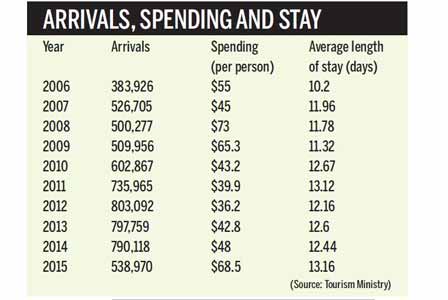

Tourist spending, stay rise as arrivals plunge

Tourist spending and length of stay rose sharply in 2015 despite arrivals plunging to a six-year low of 538,970 due to the April 25 earthquake and subsequent Tarai protests.
According to the Tourism Ministry, the average length of stay of tourists rose to an 11-year-high of 13.16 days last year. In 2014, the average length of stay was recorded at 12.44 days.
The ministry said that visitors who arrived in October stayed longer in Nepal last year. Young people between the ages of 10-24 years were the longest stayers averaging 17.55 days. The highest length of stay of 13.51 days was recorded in 2004. The shortest stay of 7.92 days was seen in 2002.
A decline in the number of strikes in 2011, when top political leaders promised not to hold shutdowns, had a positive impact on Nepal’s tourism. The average length of stay then jumped to a seven-year-high of 13.1 days, but started to drop due to political unrest.
“After the devastating earthquakes last year, the country saw increased movement of aid workers, volunteers and INGO/NGO staff, who normally stay longer, and it could be a major factor behind the rise in the average length of stay,” said Yogendra Sakya, a hotel entrepreneur. The ministry’s figures also indicate that the length of stay in Nepal was higher in the post-earthquake period—May (16.20 days), June (16.46 days) and July (16.05 days).
Meanwhile, tourist spending jumped to a seven-year-high of $68.57 per person last year from $48 in the previous year. The country earned Rs49.78 billion in tourism revenues in 2015.
Travel trade entrepreneurs said that an increase in tourism activities and expansion of sightseeing and adventure destinations had prompted visitors to spend more.
The rise in spending was not a result of higher prices during the four-month-long trade embargo when transportation, restaurants, hotels, food and beverage all became dearer, they said. “Hotel and restaurant charges remained constant during the embargo period as the country’s hospitality sector was struggling to get visitors,” said Shakya.
Hari Sarmah, CEO of the Nepal Association of Tour and Travel Agents (Natta), said that the expansion of new destinations, particularly in the adventure segment, could be a major reason behind increased tourist spending in Nepal. “Obviously, inflation has jumped significantly, but its effect on visitor expenditure is nominal as the US dollar remained constant last year.”
He said that despite a significant increase in tourist spending, Nepal is still one of the cheapest destinations in the world. “However, if international airfares are considered, it is very expensive to travel to Nepal.”
The stats show that the tourism industry accounted for 2.08 percent of the Gross Domestic Product in the fiscal year 2015-16.
source: the kathmandu post, 5 july 2016








